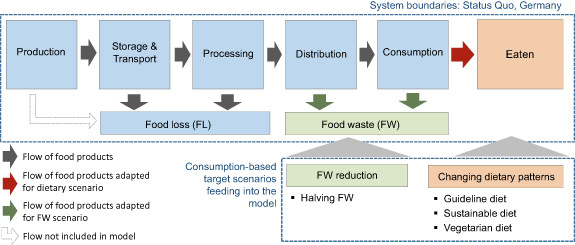April 29, 2021 | Environmental Research Letters | Source |
Introduction: Researchers from the University of Freiburg and University of Kassel (Germany), together with the Vienna University of Economics and Business (Austria), assessed how halving food waste compares with shifting to healthier, plant-based diets in reducing Germany’s food-related resource footprints. Using the Food and Agriculture Biomass Input–Output (FABIO) model, they analyzed 2013 supply chains for biomass, cropland, and blue-water use under four scenarios: current diet, German dietary guideline diet, EAT–Lancet sustainable diet, and a low-dairy vegetarian diet—each with and without a 50% food waste reduction. The study evaluated which strategies, alone or combined, deliver the greatest environmental benefits.
Key findings: Dietary changes provided far greater biomass and cropland savings than halving food waste alone. The sustainable and vegetarian diets reduced biomass use by 54–61% and cropland by 43–48%, compared with only 11% and 15% from halving waste. For blue water, halving food waste achieved the largest reduction (14%), while sustainable or vegetarian diets delivered smaller cuts (~7%) and the guideline diet even increased use by 6% unless paired with waste reduction. Combining strategies yielded the greatest benefits: a vegetarian diet plus waste reduction cut biomass by 65%, cropland by 53%, and blue water by 16%.
Yet, plant-rich diets increased the overall mass of food waste because fruits, vegetables, cereals, and roots have higher waste shares. Waste rose from 145 kg/capita/year (current) to 186 kg (guideline), 154 kg (sustainable), and 156 kg (vegetarian). This highlights a trade-off: while healthier diets reduce resource footprints, they may hinder progress on food waste targets. The authors argue that policies should integrate both strategies and track outcomes with resource footprint indicators, rather than waste volumes alone, to avoid misleading priorities and maximize environmental gains.

Figure | System definition and boundaries. The supply chains are global and defined based on the food consumed and eaten in Germany. The system processes are defined according to FAO (2011).





